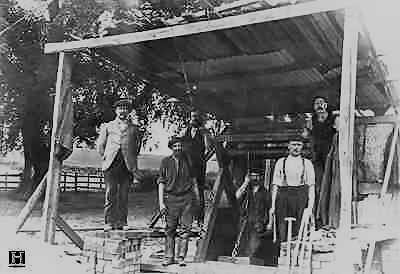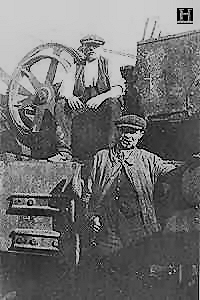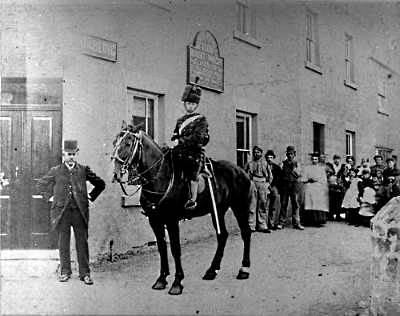A Hucknall History
Industrial Developments
A New Hucknall Colliery
Founder behind the last and most productive Huthwaite coal mine was William Muschamp Esquire (1812-1875). Ancestral name long recognises wealthy gentry and influential businessmen amongst Newcastle upon Tyne area. William is identified as one long standing councillor representing the large town of Gateshead-on-Tyne. In 1872 Muschamp held more distinguished title of Mayor to Gateshead Metropolitan Borough Council. His personal enterprises then became aimed at reaching elusive Nottinghamshire coals.
Closure of Mellors largest productive coal pit appears to have attracted attention of Mr William Muschamp towards a rural Hucknall Huthwaite setting. The Mellors mining family had asserted several coal seams lay beneath their workable limitations, but even their extensive drift mine below Blackwell Road could not compare with deeper exploitation of coals long being shipped from the Tyne.
Purchasing mineral rights from Natham Mellors suggests Muschamp intended reopening those works. However, buying more rights from a Mrs Miller and members of the Society of Friends, plus a locally reputed J T Boot for another £1400, investment costs are inflated by furthermore employing the widely renown services of that mineral surveyor and mining engineer. But all that makes it apparent their next intention was better siting a much larger colliery upon former Dirty Hucknall lower Fulwood Common grounds.
Negotiating all necessary land and mineral leasing rights through John Boot & Sons inexplicably delayed any work commencing. It was some eights years after closing the old pit, thereafter called the Old Hucknall Colliery, before the first shovel could be used. Unfortunately for William Muschamp, his death when aged 65, dated 30th December 1875 in Gateshead, Durham, meant he never got to see results of his investment. Appointed executors and five other private investors actually ensured work could begin just a few months later. It was they who'd choose name when officially constituting their 1879 New Hucknall Colliery Company.
Sinking a Final Huthwaite Coal Mine
Digging out Huthwaite's future prosperity is shown started in year 1876,  when these workers sink the first New Hucknall pit shaft.
when these workers sink the first New Hucknall pit shaft.
A Top Hard seam of Barnsley bed is first reached, leading quickly on to sinking a second shaft to provide clean air circulation. Both shafts were named in a tribute to this areas titled land owning manor Lord. No.1 was Carnarvon. North side coals were firstly raised through No.2 Portland by 1877. This only started to next invite a wide range of jobs, in order to begin a productive year 1878.
Seeing initial use of a simple hand winch for lowering miners and slowly raising buckets of earth,  would be same method long employed by early shallower bell pits. Workers clinging onto the chains was still a dangerous transfer after far deeper collieries made greater use of pony power both above and underground. Their perilous swinging descent was noted at the Old Hucknall pit, unchanged after using steam powered machinery.
would be same method long employed by early shallower bell pits. Workers clinging onto the chains was still a dangerous transfer after far deeper collieries made greater use of pony power both above and underground. Their perilous swinging descent was noted at the Old Hucknall pit, unchanged after using steam powered machinery.
This 1878 New Hucknall winder steam engine can barely claim any safety improvements, until adding a transportation cage. What it did have was the power to increase depth and capacity for retrieving much heavier pay loads. New Hucknall colliery was destined to be just one of many Nottinghamshire coal pits aimed at the previously elusive seams stretching deeper eastward.
Nearest the Derbyshire border, here finally met a watery working limit over a quarter mile below ground. But in order to fully reach lower seams, New Hucknall Colliery rather uniquely featured a third pit shaft sunk between years 1884-1887. Opening that shaft allowed the colliery to work at full capacity, and sets date for the urgent need to start providing houses for the expected employment of over 1,500 miners. Considering that well out numbered the entire Hucknall-under-Huthwaite population at time, is good indication of the significant part this pit played in quickly transforming this rural hamlet into an industrious mining community and a relatively prosperous township.

Wrights Yard housing plus the further opening of their Workpeoples Inn were among other private endevours aimed at accommodating an influx of thirsty miners.
Elliott great grandparents brought surname and family from Pinxton to extend three generation working at this Huthwaite pit. Their lifetime homes in Hopkins terracing relates former lane behind the present Blackwell Road.

27 Aug 03 by Gary Elliott Updated 24 Oct 23
